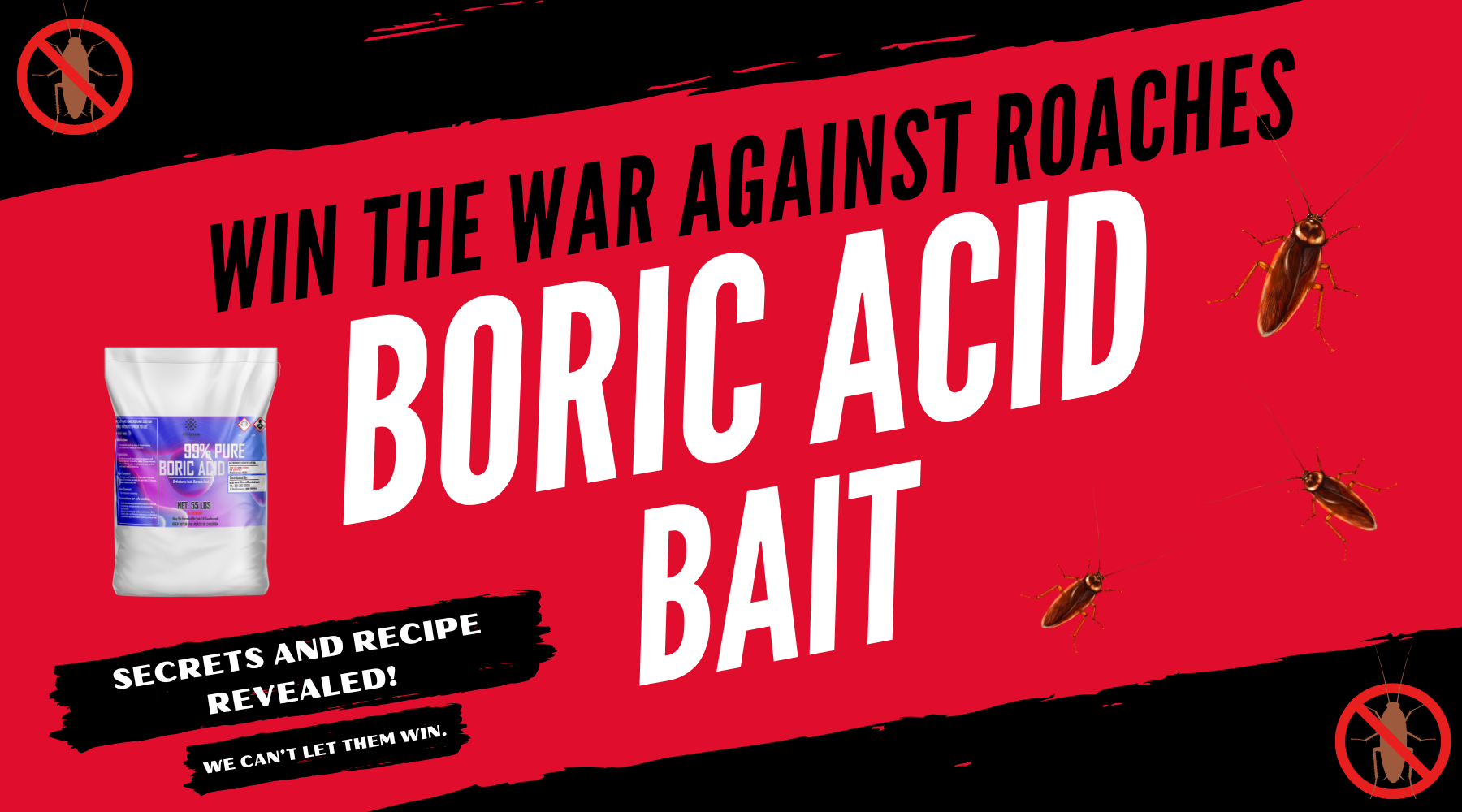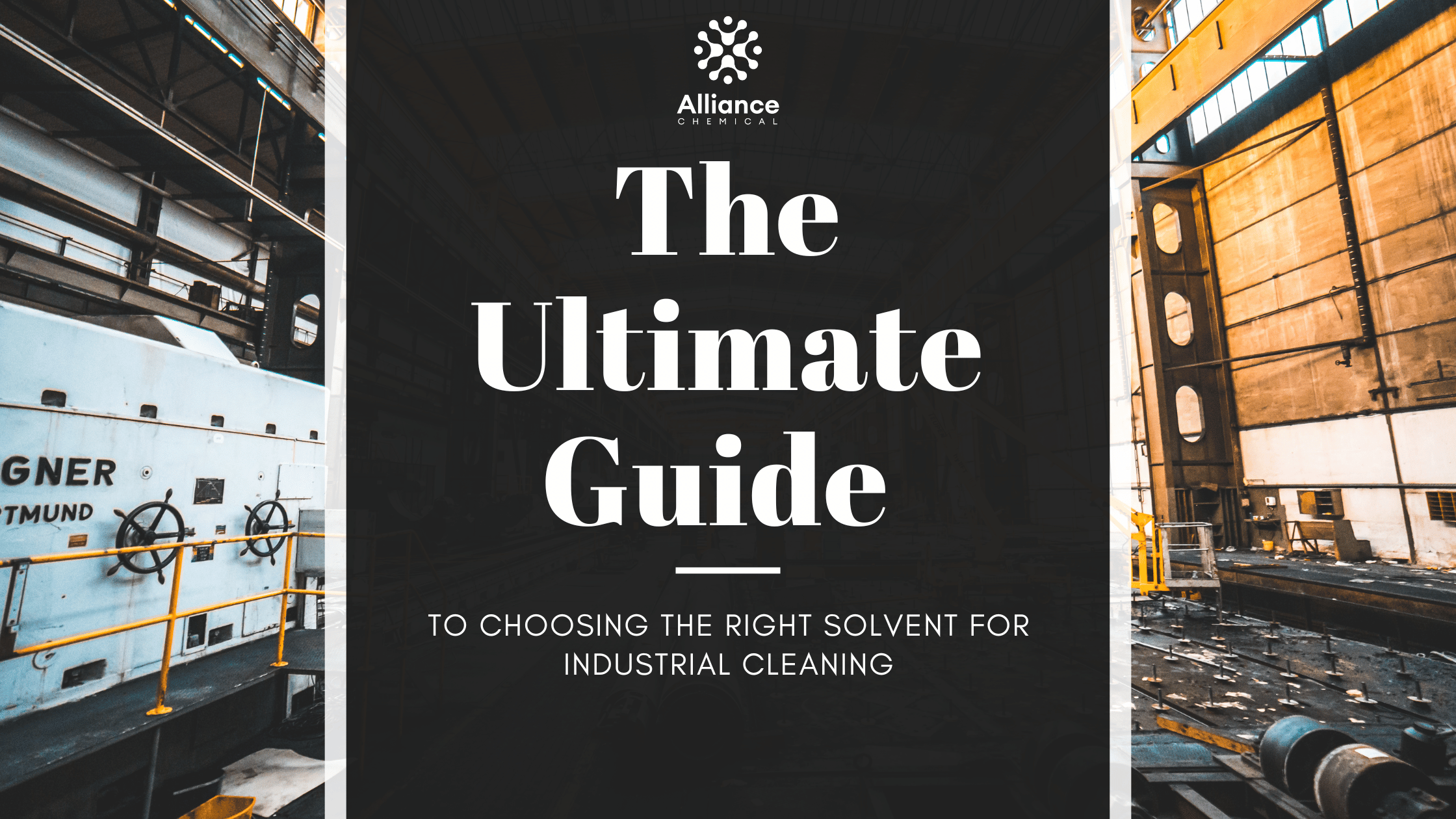
Win the War Against Roaches: Boric Acid Bait Secrets Revealed
Few household pests spark universal frustration and disgust quite like cockroaches. These nocturnal invaders aren’t just unwelcome houseguests; they can spread allergens, trigger asthma, contaminate food, and destroy your sense of peace at home. Seeing them scatter when you turn on a light is a uniquely unsettling experience.
The good news? You can fight back effectively. This comprehensive guide reveals the secrets to using **boric acid**, a time-tested and powerful weapon, to create irresistible baits that eliminate roach infestations. We'll cover everything from understanding your enemy and crafting the perfect bait to strategic placement, safety measures, and even natural complements like **D-Limonene**. Discover how to leverage quality ingredients from Alliance Chemical to win the war against roaches for good.
Ready to arm yourself with knowledge and reclaim your space? Let's begin.
1. A Brief History of Cockroaches: Earth's Ultimate Survivors
To defeat your enemy, you must understand them. Cockroaches aren't recent pests; their lineage stretches back hundreds of millions of years, predating even the dinosaurs. Their incredible evolutionary success story explains why they are such masters of survival and stealth.
1.1 Deep Evolutionary Roots
Fossil evidence indicates cockroaches have existed for at least 320 million years1. They witnessed the rise and fall of dinosaurs and survived multiple global extinction events that wiped out countless other species. This ancient heritage has equipped them with remarkable adaptability and resilience.
1.2 Why They Thrive Alongside Humans
Human settlements provide cockroaches with ideal conditions: abundant food sources (our crumbs, spills, garbage), ample water (leaky pipes, condensation), warmth, and countless dark, tight hiding places (cracks, crevices, clutter). They have co-evolved alongside us, becoming experts at exploiting our environments.
Cockroaches didn't just survive geological time; they mastered the art of living in the shadows, making our homes their preferred real estate.
Recognizing their deep-seated survival instincts is the first step toward developing a control strategy that works. Superficial measures often fail because roaches are programmed to overcome temporary threats.
2. Why Cockroaches Are So Hard to Kill
If you've battled roaches before, you know they seem almost indestructible. Several biological and behavioral traits contribute to their reputation as some of the planet's most resilient pests.
2.1 Unfussy Eaters (Omnivorous)
They aren't picky. Roaches will consume almost anything organic: food scraps, grease, glue, soap, wallpaper paste, book bindings, cardboard, fabrics, and even the shed skins or dead bodies of other roaches. This makes starvation an ineffective control method.
2.2 Explosive Reproduction
Cockroaches reproduce rapidly and prolifically. A single female German cockroach (the most common indoor pest species) can produce several egg cases (oothecae) in her lifetime, each containing 30-40 eggs. Under ideal conditions, one pregnant female can lead to an infestation numbering in the thousands within a year2.
2.3 Remarkable Hardiness & Resistance
Their physical toughness is legendary. They can survive high levels of radiation (though the "nuclear apocalypse survivor" claim is exaggerated), withstand significant physical pressure (allowing them to squeeze through tiny cracks), and even live for about a week without a head (eventually dying of dehydration). Critically, many populations have developed significant physiological resistance to common chemical insecticides through rapid adaptation3.
2.4 Masters of Stealth (Nocturnal & Thigmotactic)
Roaches are primarily active at night, avoiding detection. They exhibit thigmotaxis – a preference for tight spaces and contact with surfaces – leading them to hide deep within cracks, crevices, wall voids, and under appliances during the day. Their sensitive cerci (appendages on their rear) detect minute air currents, alerting them to approaching danger long before you see them.

Their ability to eat anything, breed quickly, resist chemicals, and hide effectively makes controlling cockroaches a true challenge requiring strategic intervention.
3. Preparing Your Battle Plan: Integrated Pest Management (IPM)
Forget relying solely on a can of roach spray. Effective, long-term cockroach control requires an Integrated Pest Management (IPM) approach. IPM combines multiple tactics – focusing on prevention and non-chemical methods first – to manage pests safely and sustainably.
3.1 Step 1: Inspection & Monitoring
- Identify the Enemy: Determine the species (usually German or American indoors) as control methods can vary slightly.
- Locate Hotspots: Use a flashlight to inspect dark, warm, moist areas at night (kitchen, bathrooms, utility rooms). Look for live roaches, droppings (like black pepper), egg cases, and shed skins.
- Use Sticky Traps: Place glue traps flat against walls under sinks, behind the refrigerator/stove, and inside cabinets. Check them weekly to pinpoint high-traffic areas and monitor population changes.
3.2 Step 2: Sanitation – Remove Food, Water & Shelter
- Eliminate Food Sources: Store ALL food (including pet food) in sealed containers. Clean up spills and crumbs immediately. Wash dishes promptly. Empty trash cans nightly (use bins with tight lids). Clean grease buildup from stoves and vents.
- Remove Water Sources: Fix all leaks (pipes, faucets, roofs). Dry sinks and tubs nightly. Address condensation issues. Empty pet water bowls overnight if possible.
- Reduce Harborage (Shelter): Declutter! Remove piles of paper, cardboard boxes, magazines, and unused items, especially near kitchen/bathroom areas. Roaches love cardboard and paper clutter.
3.3 Step 3: Exclusion – Block Their Entry & Movement
- Seal Cracks & Crevices: Use caulk or sealant to close gaps around pipes, baseboards, countertops, window/door frames, electrical outlets, and where cabinets meet walls. Pay special attention to gaps between apartments in multi-unit dwellings.
- Screen Vents & Drains: Ensure vents and floor drains have tight-fitting screens.
3.4 Step 4: Targeted Control Methods (Where Boric Acid Shines)
- Baits (Primary): Use slow-acting baits like **boric acid baits** (Section 5) placed strategically in hidden areas identified during inspection (Section 6).
- Dusts (Supplemental): Apply **boric acid dust** carefully into wall voids, behind electrical plates (turn off power first!), under heavy appliances, and in attics/crawlspaces (Section 6).
- Other Tools: Consider Insect Growth Regulators (IGRs) to disrupt reproduction, or targeted use of low-impact contact sprays (like D-Limonene, Section 8) if needed, ensuring they don't interfere with bait acceptance.
IPM is a systematic approach: inspect, clean, exclude, and then apply targeted treatments like boric acid. It addresses the root causes, not just the symptoms.
4. Boric Acid 101: The Unsung Hero of Roach Control
Amidst a market flooded with complex chemical sprays, **boric acid** (

4.1 How Boric Acid Kills Roaches
Boric acid employs a multi-pronged attack:
- Stomach Poison: When roaches ingest boric acid (either by eating bait or grooming powder off their bodies), it disrupts their metabolism and damages their digestive system. They slowly stop eating and eventually die from starvation and internal damage.
- Exoskeleton Abrasion: The microscopic crystals of boric acid powder are abrasive to the waxy outer layer (cuticle) of a roach's exoskeleton. This physical damage impairs the cuticle's ability to retain moisture, leading to dehydration (desiccation).
- Nervous System Effects (Secondary): While primarily a stomach poison and desiccant, some studies suggest boric acid may also have secondary effects on the insect nervous system at sufficient doses.
- Transfer Effect: Roaches contaminated with boric acid powder carry it back to their hidden nests (harborages). Other roaches become exposed through direct contact, grooming, or even cannibalism of dead roaches, potentially leading to control of individuals that never directly encountered the initial application.
4.2 Key Advantages for Roach Control
- Long-Lasting Residual: Boric acid powder remains effective indefinitely as long as it stays dry. A single application in a wall void or under a cabinet can provide protection for months or even years.
- Minimal Resistance: Unlike neurotoxic insecticides that target specific nerve receptors (where resistance mutations can arise), boric acid's primary modes of action (stomach poison, physical abrasion) make it extremely difficult for roaches to develop physiological resistance4.
- Non-Repellent: Roaches generally do not detect or avoid boric acid powder or properly formulated baits, increasing the likelihood of lethal exposure.
- Relatively Low Mammalian Toxicity: Compared to many synthetic organic pesticides, boric acid has lower acute toxicity to humans and pets *if used as directed*. However, it is still toxic if ingested, so safety precautions are essential (Section 7).
- Cost-Effective: Boric acid is generally inexpensive, especially when purchased as a technical grade powder for bait formulation or dusting.
4.3 Choosing the Right Boric Acid
For pest control, **Technical Grade Boric Acid** is typically the most suitable and cost-effective option. Higher purity grades (like lab or pharmaceutical grade) are unnecessary. Ensure you purchase from a reputable source to guarantee quality.
- Alliance Chemical Boric Acid (Technical Grade): Provides the quality needed for reliable bait and dust applications.
Boric acid is a slow but relentless killer. Its persistence, lack of resistance, and multiple modes of action make it an indispensable tool against resilient cockroach populations.
5. Crafting the Perfect Boric Acid Bait: Recipes & Tips
While commercial boric acid baits are available, creating your own allows for customization, freshness, and cost savings. The secret lies in making the bait highly attractive to roaches while incorporating enough boric acid to be lethal, but not so much that it becomes repellent.
The Golden Ratio: Palatability is Key
Successful baits typically use a **low concentration** of boric acid relative to the food ingredients. Aim for approximately **1 part boric acid to 3-5 parts food attractants** by volume. Too much boric acid tastes bad to roaches or kills them too fast before they can return to the nest and potentially share the toxicant.
5.1 Recipe 1: The Classic Sweet & Starchy Dough
This is a balanced, widely effective bait.
Ingredients:
- 1/4 cup Boric Acid Powder
- 1/2 cup All-Purpose Flour (binder, starch)
- 1/4 cup Powdered Sugar (sweet attractant)
- Optional: 1 tablespoon Cocoa Powder (added attractant)
- Water or Milk (just enough to bind)
Instructions:
- Wear gloves. In a disposable bowl, thoroughly mix all dry ingredients.
- Slowly add tiny amounts of water or milk, mixing until a stiff, pliable dough forms (like play-dough). Avoid making it sticky or wet.
- Roll into very small balls (pea-sized) or flatten into thin discs (dime-sized).
- Place baits strategically (Section 6). Use wax paper squares or bottle caps under baits to protect surfaces.
5.2 Recipe 2: High-Protein & Fat Lure
Good for species potentially less attracted to sugar, or as an alternative bait.
Ingredients:
- 1 tablespoon Boric Acid Powder
- 3 tablespoons Peanut Butter (fat/protein)
- 1 tablespoon Bacon Grease (optional, strong attractant) OR 1 tsp finely crushed dry pet food
Instructions:
- Wear gloves. Thoroughly mix boric acid into peanut butter and any optional ingredients until evenly combined.
- Place small dabs (pea-sized) onto wax paper squares or inside bottle caps.
- **Caution:** Highly attractive to pets. Place ONLY in areas completely inaccessible to them (e.g., deep behind heavy appliances).
5.3 Recipe 3: Simple Sugar & Boric Acid Paste
Easy to mix, good for dabbing into crevices.
Ingredients:
- 1 part Boric Acid Powder
- 3 parts Powdered Sugar
- Water (just enough to make a thick paste)
Instructions:
- Wear gloves. Mix boric acid and powdered sugar.
- Add water drop by drop, mixing until a thick, non-runny paste forms.
- Use a small stick or putty knife to apply small dabs of paste directly into cracks, crevices, behind outlet covers (power off!), or along hidden cabinet edges.
5.4 Baiting Tips for Maximum Effectiveness
- Small is Better: Roaches prefer small, discrete food sources. Make your baits tiny.
- Placement is Crucial: Put baits directly in roach pathways and near harborages (Section 6).
- Maintain Freshness: Replace baits every 2-4 weeks, or sooner if they dry out, get moldy, or become covered in dust. Roaches prefer fresh bait.
- Offer Variety: If one bait type isn't being readily consumed after a week or two, try a different recipe. Roach preferences can vary.
- Patience: Boric acid is slow-acting. Don't expect overnight results. Consistent baiting over several weeks is needed for population control.
Your homemade bait is a targeted weapon. Make it irresistible and place it cleverly to ensure the roaches take their final meal.
6. Strategic Placement: Where and How to Apply Baits & Dusts
Effective boric acid application isn't about spreading it everywhere; it's about precision. You need to place baits and dusts where cockroaches travel, feed, and hide, maximizing their exposure while minimizing contact for humans and pets.
6.1 Prime Locations for Baits and Dusts
Focus on areas that offer warmth, moisture, darkness, and proximity to food/water:
-
Kitchen Hotspots:
- Under and behind the refrigerator (especially near the motor), stove, dishwasher, microwave.
- Inside cabinet corners, under the sink (especially around pipes), along kick plates.
- Behind drawers, inside the pantry (along edges/corners).
- Near trash cans.
-
Bathroom Hotspots:
- Under the sink, around pipes.
- Behind the toilet.
- Inside vanity cabinet corners.
- Near floor drains (if applicable).
-
Other Potential Areas:
- Laundry rooms (behind washer/dryer, near water heater).
- Basements or crawl spaces (along sill plates, near pipes).
- Wall voids (accessed via plumbing/electrical openings - ideal for dust).
- Behind wall clocks, picture frames, or inside electronics (less common but possible).
- Attics (especially near vents or water intrusion).
6.2 Application Techniques: Baits vs. Dusts
Applying Baits (Dough, Paste, Gel):
- Place small, pea-sized amounts directly into or along cracks, crevices, corners, and hidden edges.
- Use wax paper, foil squares, or bottle caps under baits on surfaces to prevent staining and ease cleanup.
- Utilize tamper-resistant bait stations for protection in higher-risk areas.
- Apply numerous small placements rather than a few large ones.
Applying Boric Acid Dust:
- Use a specialized **bulb duster** or **puffer bottle** for application. Do NOT just sprinkle from the container.
- Aim for a **very fine, barely visible layer** inside wall voids, under appliances (where inaccessible), behind electrical switch plates (power OFF first!), along attic joists, etc.
- Roaches need to walk *through* the dust unknowingly; thick piles are often repellent and less effective.
- Dust remains effective as long as it stays dry. Ideal for long-term control in undisturbed areas.
- Wear a dust mask and eye protection during application.
Think Like a Roach
Place baits and dusts along the hidden "highways" roaches use – the edges where walls meet floors or ceilings, the dark corners inside cabinets, the paths around pipes. They prefer contact with surfaces as they move.
6.3 Maintenance and Monitoring
- Check baits periodically (e.g., weekly) and replace as needed (consumed, dried, moldy, dusty).
- Monitor sticky traps placed near baited areas to gauge activity levels and bait consumption. If traps remain full but baits untouched, consider changing bait type or placement.
- Keep applied dust dry and undisturbed. Reapply dust only if the initial application gets wet or removed.
Precision placement is key. Put the boric acid where the roaches *will be*, not just where you *have seen* them, maximizing encounter probability while ensuring safety.
7. Safety First: Handling Boric Acid Responsibly
While often described as having "low toxicity" compared to other insecticides, boric acid is still a chemical and must be handled with appropriate care to protect yourself, your family, pets, and the environment. Always follow label instructions and these best practices.
7.1 Personal Protective Equipment (PPE)
- Gloves: Wear disposable, waterproof gloves (e.g., nitrile) when handling boric acid powder, mixing baits, or placing applications. This prevents skin absorption and potential irritation.
- Eye Protection: Use safety glasses, especially when working with the powder, to prevent accidental contact and irritation.
- Dust Mask/Respirator: Crucial when applying boric acid as a dust. Use at least an N95-rated mask to avoid inhaling fine particles, which can irritate the respiratory system. Ensure good ventilation during dusting.
7.2 Application Safety
- Targeted Placement ONLY: Apply boric acid *only* in cracks, crevices, wall voids, under/behind inaccessible appliances, and inside tamper-resistant bait stations.
- NEVER Apply Where Accessible: Do **NOT** apply boric acid powder or baits on countertops, tables, shelves, food preparation surfaces, floors where children crawl or pets walk, inside utensil drawers, or anywhere direct contact by non-targets is possible.
- Avoid Food Contamination: Keep boric acid far away from food, drinks, pet food, dishes, and cooking utensils during storage, mixing, and application.
- Use Minimal Effective Amount: Apply only the amount needed. A fine layer of dust or small bait placements are more effective and safer than large piles.
7.3 Storage and Disposal
- Secure, Labeled Storage: Store boric acid in its original, tightly closed container, clearly labeled, and completely out of reach of children and pets (e.g., high shelf, locked cabinet).
- Dry Conditions: Store in a cool, dry place to maintain powder integrity.
- Proper Disposal: Do not discard excess boric acid or baits down drains or in regular household trash unless specifically allowed by your local waste authority. Contact them or your local hazardous waste disposal facility for guidance on proper disposal methods. Clean up spills promptly and carefully.
7.4 First Aid & Emergency Reference
Keep emergency contact information readily available (e.g., Poison Control: 1-800-222-1222 in the US). Always refer to the product label and Safety Data Sheet (SDS) for specific first-aid measures. General advice:
- Skin: Wash area with soap and water.
- Eyes: Flush gently with water for 15-20 minutes. Seek medical advice if irritation persists.
- Inhalation (Dust): Move to fresh air. Seek medical attention if breathing difficulties occur.
- Ingestion: **Call Poison Control or a doctor immediately.** Do not induce vomiting unless instructed. Have the product container/label available.
Mandatory Reading: The SDS
The Safety Data Sheet (SDS) contains critical hazard, handling, storage, and first aid information. Before using any chemical, review its SDS. Access the SDS for Alliance Chemical's Boric Acid here: Boric Acid SDS.
Safety isn't optional. Responsible handling and precise, inaccessible placement are paramount when using boric acid for pest control.
8. Natural Alternatives & Complements: Spotlight on D-Limonene
Integrating natural products can enhance your pest control strategy, often providing faster knockdown or repellent action that complements boric acid's slow, steady work. **D-Limonene**, a solvent extracted from citrus peels, is a popular choice due to its pleasant scent (to humans) and insecticidal properties.
8.1 Understanding D-Limonene's Action
- Contact Insecticide: D-Limonene works primarily by dissolving the waxy coating on an insect's exoskeleton upon direct contact. This leads to rapid water loss (desiccation) and respiratory failure. It can also act as a nerve toxin to insects in sufficient concentrations6.
- Repellent Effect: The strong citrus aroma is irritating and repellent to many insects, including cockroaches, potentially deterring them from treated surfaces or areas.
- Cleaning Agent: Its excellent solvent properties make it effective at cutting through grease and grime, helping to remove food residues and scent trails that attract roaches.
- Natural & Biodegradable: Derived from citrus peels, it's considered a more natural alternative to synthetic pesticides and breaks down relatively quickly in the environment.
8.2 Using D-Limonene in Roach Control
- DIY Contact Spray: Dilute D-Limonene Technical Grade with water (typically 1-5% concentration, may require an emulsifier like mild soap for mixing – follow specific recipe guidelines) in a spray bottle. Spray directly onto visible roaches for quick kill.
- Cleaning Solution Additive: Add a small amount of D-Limonene to your regular floor or surface cleaning solution (test for surface compatibility first!) to enhance cleaning and leave a repellent scent.
- Flushing Agent: Spraying diluted D-Limonene into cracks and crevices can sometimes irritate roaches enough to flush them out of hiding.
- Scent Deterrent: Wiping down potential entry points or applying a D-Limonene solution near thresholds might help deter roaches from entering.
8.3 Important Considerations
- Direct Contact Needed: Its killing action requires direct spray contact. Residual effectiveness as an insecticide is limited.
- Repellency vs. Baiting: **Crucial Point:** Do NOT spray D-Limonene directly on or near your boric acid baits, as the repellent odor will likely prevent roaches from taking the bait. Use them in different locations or at different times (Section 9).
- Surface Safety: Concentrated D-Limonene is a strong solvent and can damage certain plastics, rubber, asphalt, or finished surfaces. Always dilute properly and test on an inconspicuous spot first.
- Ventilation & Sensitivity: Use in well-ventilated areas. While natural, the strong scent can be irritating to sensitive individuals or pets. Avoid direct skin contact with concentrates; wear gloves.
High-Quality Citrus Power
For effective cleaning and insecticidal action, use a reliable D-Limonene source like Alliance Chemical's D-Limonene Technical Grade.
D-Limonene adds a fast-acting, natural dimension to your roach control plan, excelling as a contact killer, cleaner, and repellent when used strategically.
9. Combining Tactics: Using Boric Acid with D-Limonene
Leveraging both boric acid's persistence and D-Limonene's quick action can create a more robust and effective cockroach control program than using either alone. The key is *strategic* integration, ensuring one method doesn't undermine the other.
9.1 Why Combine Them?
- Complementary Actions: Boric acid provides slow, long-term, colony-level control via ingestion/contact. D-Limonene offers immediate knockdown of visible pests and area repellency/cleaning.
- Addressing Different Stages/Locations: D-Limonene can target foraging roaches in open areas or near entry points, while boric acid works silently in hidden harborages and pathways.
- Enhanced Sanitation: D-Limonene's cleaning power helps remove attractants, making boric acid baits relatively more appealing.
- Reduced Chemical Footprint: Combining these relatively lower-impact options can potentially reduce the need for harsher synthetic pesticides.
9.2 Smart Integration Strategies (Avoiding Conflicts)
Remember: D-Limonene's repellency can counteract boric acid baits if applied improperly.
-
Perimeter Repellency, Interior Baiting (Spatial Separation):
- Use D-Limonene based cleaners or diluted sprays on surfaces *around* potential entry points (door thresholds, window sills, baseboards in hallways).
- Place boric acid baits and dusts *deep inside* target areas like under kitchen/bathroom sinks, behind appliances, inside cabinet corners, and in wall voids – away from the D-Limonene treated perimeters.
-
Initial Clean & Flush, Delayed Baiting (Temporal Separation):
- Perform a thorough cleaning using a D-Limonene based cleaner to remove grease and grime.
- Optionally, use a diluted D-Limonene spray for a quick flush/kill in heavily infested cracks (allow area to ventilate well afterwards).
- Wait 1-2 days for the strong citrus scent to dissipate significantly *before* placing boric acid baits in those cleaned/flushed areas.
- Contact Kill Supplement: Keep a spray bottle of diluted D-Limonene handy for directly spraying any roaches you see out in the open, while relying on strategically placed boric acid baits/dusts for the hidden population.
9.3 What NOT To Do
- Do NOT spray D-Limonene directly onto boric acid baits or dust applications.
- Do NOT apply D-Limonene heavily in the immediate vicinity where baits are placed, especially just before or after baiting.
- Avoid using strongly scented air fresheners or cleaners near bait locations, as these can also be repellent.
Think of it as a coordinated attack: D-Limonene handles the perimeter guards and visible scouts, while boric acid infiltrates the hidden barracks for long-term impact.
10. Alliance Chemical: Your Source for Quality Ingredients
Achieving effective pest control often comes down to the quality and reliability of the active ingredients you use. Alliance Chemical provides dependable access to key components like boric acid and D-Limonene, supporting both DIY homeowners and pest control professionals.
10.1 Featured Products for Roach Control
- Boric Acid (Technical Grade): The essential ingredient for potent, long-lasting roach baits and dusts. Sourced for reliable purity and particle size suitable for pest control.
- D-Limonene (Technical Grade): High-quality citrus solvent for effective natural contact killing, cleaning, and repelling applications.
10.2 Why Quality Matters
- Consistency: Reliable chemical purity and physical properties (like powder fineness) ensure predictable performance in baits and dusts.
- Effectiveness: Using properly specified grades (like Technical Grade Boric Acid) ensures you have the right material for the job, maximizing efficacy against pests.
- Safety Information: Reputable suppliers provide easy access to critical Safety Data Sheets (SDS), enabling safe handling and use.
10.3 Beyond the Basics
Alliance Chemical also offers related products that can support your overall IPM program:
- Cleaning & Degreasing Agents: Essential for the sanitation aspect of roach control.
- Appropriate Containers: For safe storage of bulk chemicals or prepared baits.
- Support & Service: Assistance with product selection, bulk orders, and logistical needs.
Partner with Alliance Chemical
Whether formulating DIY baits or needing reliable components for professional pest management, Alliance Chemical offers quality products, accessible safety data, and dedicated service. Explore our full product catalog or contact us for specific needs.
Effective pest control starts with quality ingredients. Trust Alliance Chemical for the reliable boric acid and D-Limonene needed to win your war against roaches.
11. Frequently Asked Questions (FAQs) about Boric Acid for Roaches
- Q1: Is boric acid safe to use around food preparation areas?
- Answer: NO. Boric acid should **never** be applied directly on countertops, cutting boards, inside pantries where food is stored openly, or anywhere it could contaminate food, dishes, or utensils. Apply only in inaccessible cracks, crevices, voids, or bait stations away from food prep zones.
- Q2: How is boric acid different from borax?
-
Answer: They are related boron compounds but chemically different. Boric acid (
H₃BO₃ ) is generally considered more effective as an insecticide than borax (sodium tetraborate decahydrate,Na₂B₄O₇·10H₂O ). While borax has some insecticidal properties, boric acid is the preferred material for roach baits and dusts due to its higher efficacy. - Q3: Can I just sprinkle boric acid powder around my kitchen floor?
- Answer: This is **not recommended** and is unsafe. Roaches may avoid thick piles, it creates an inhalation hazard, and it poses a risk to children and pets walking through it and potentially ingesting it later via grooming. Apply only as a fine, barely visible dust in hidden, inaccessible areas using a bulb duster, or use formulated baits.
- Q4: Does boric acid kill roach eggs?
- Answer: No, boric acid does not effectively penetrate the protective egg case (ootheca). It kills nymphs after they hatch and come into contact with the powder or bait, and adult roaches. This is why long-term application/baiting is necessary – to catch newly hatched individuals.
- Q5: Why isn't my boric acid bait working?
-
Answer: Several reasons are possible:
- Placement: Baits might not be located where roaches are actively foraging. Re-inspect and adjust placement based on monitoring traps.
- Palatability: The bait recipe might not be attractive to your specific roach population, or the boric acid concentration might be too high. Try a different recipe or lower the boric acid ratio.
- Competing Food Sources: Poor sanitation means roaches have plenty of other things to eat and may ignore your bait. Improve cleaning efforts drastically.
- Bait Freshness: Old, dried out, or moldy bait is unattractive. Replace baits regularly.
- Moisture: If boric acid powder gets wet, its effectiveness is greatly reduced. Ensure dust applications stay dry.
- Q6: Is boric acid harmful to plants?
- Answer: Boron is an essential micronutrient for plants, but excessive amounts are toxic. Avoid applying boric acid directly to soil or plants unless specifically intended as a boron supplement (at very low, controlled rates). Keep pesticide applications away from garden areas or houseplants.
12. Real-World Success: Case Studies
Seeing how others have successfully used boric acid can provide valuable insights and confidence. Here are two typical scenarios:
12.1 Case Study: Persistent Kitchen Infestation (Homeowner)
- Situation: A homeowner consistently saw several German cockroaches nightly in their kitchen, particularly around the sink and dishwasher, despite using store-bought sprays periodically.
-
Action Taken:
- Thoroughly cleaned under/behind appliances, removing grease buildup.
- Fixed a minor drip under the sink.
- Made boric acid/powdered sugar/flour dough balls (Recipe 1).
- Placed baits on small wax paper squares deep under the sink cabinet, behind the dishwasher panel, behind the refrigerator, and inside lower cabinet corners.
- Used sticky traps to monitor.
- Result: Initial trap counts were high. After 1 week, dead roaches were found near bait placements. After 3 weeks, nighttime sightings decreased dramatically. Trap counts were near zero after 6 weeks. Continued monitoring and replacing baits monthly prevented re-infestation.
12.2 Case Study: Restaurant Storage Area (Professional IPM)
- Situation: A restaurant's dry storage room had a recurring issue with American cockroaches entering from outside and finding harborage among stored goods and shelving units. Previous treatments focused only on perimeter sprays.
-
Action Taken:
- Sealed gaps around utility conduits entering the room.
- Educated staff on keeping the floor clean of spilled food items.
- Applied a fine layer of boric acid dust using a bulb duster along wall edges behind shelving units and into known crevices.
- Placed several large, tamper-resistant bait stations containing a commercial boric acid granular bait along walls.
- Installed sticky traps for monitoring.
- Result: Monitoring traps showed significant activity initially, but counts steadily declined over the following two months. The boric acid dust provided long-lasting control in hidden areas, while the granular bait targeted foraging adults. Addressing entry points and sanitation was also critical. The restaurant achieved sustained control with quarterly inspections and touch-up applications as needed.
These cases demonstrate that consistent application of boric acid in strategic locations, combined with sanitation and exclusion, is highly effective for both minor and challenging cockroach infestations.
13. Conclusion: Achieving Long-Term Victory
Cockroaches are ancient survivors, experts at exploiting our living spaces. But they are not unbeatable. Armed with the right knowledge and the persistent power of **boric acid**, you can turn the tide and reclaim your home or business from these unwelcome invaders.
Remember that success lies not in a single application, but in a comprehensive **Integrated Pest Management (IPM)** strategy. By combining meticulous **sanitation**, diligent **exclusion** (sealing entry points), careful **monitoring**, and the **strategic application** of effective, low-resistance tools like boric acid baits and dusts, you address the infestation from multiple angles.
Key takeaways for winning the war:
- Boric acid offers long-lasting, non-repellent control with minimal resistance issues.
- Proper bait formulation (low boric acid concentration, attractive food source) is crucial for ingestion.
- Strategic placement in hidden pathways and harborages maximizes effectiveness and safety.
- Applying dust correctly (fine layer in inaccessible areas) provides durable residual control.
- Sanitation and exclusion are non-negotiable parts of any long-term solution.
- Natural complements like D-Limonene can enhance your strategy when used thoughtfully.
- Safety precautions (PPE, careful placement, proper storage) are paramount.
- Persistence pays off; boric acid is slow but steady.
Utilize high-quality ingredients, like those available from Alliance Chemical, follow safety guidelines diligently, and maintain your efforts consistently. With this approach, you can achieve lasting victory over even the most stubborn cockroach populations.
Ready to Fight Back?
Equip yourself with Technical Grade Boric Acid from Alliance Chemical and implement the strategies in this guide. Take control and enjoy a roach-free environment!
The battle against roaches is winnable. Combine knowledge, persistence, sanitation, and the proven effectiveness of boric acid to secure your victory.
14. References & Further Reading
Expand your knowledge with these resources:
- Graczyk, T. K., Knight, R., & Tamang, L. (2005). Mechanical transport and transmission of pathogens by synanthropic cockroaches. Clinical Microbiology Reviews, 18(1), 128–132.
- Appel, A. G., & Smith, L. M. (2002). Biology and management of the German cockroach. Annual Review of Entomology, 47, 33–55.
- Dong, K., et al. (2014). Molecular mechanisms of insecticide resistance. Annual Review of Entomology, 59, 145–163.
- Ebeling, W. (1994). Chapter 5: Pests On or Near Food. In Urban Entomology. University of California Division of Agriculture and Natural Resources. (Contains discussion on boric acid effectiveness and lack of resistance).
- U.S. Environmental Protection Agency. (1993). Reregistration Eligibility Decision (RED) for Boric Acid and its Sodium Salts. EPA 738-R-93-017. (Link to PDF)
- Karr, L. L., & Coats, J. R. (1992). Effects of four monoterpenoids on growth and reproduction of the German cockroach (Blattodea: Blattellidae). Journal of Economic Entomology, 85(2), 424–429.
- Alliance Chemical. (n.d.). Boric Acid Technical Grade Product Page.
- Alliance Chemical. (n.d.). Safety Data Sheet (SDS) - Boric Acid Technical.
- Alliance Chemical. (n.d.). D-Limonene Technical Grade Product Page.
- National Pesticide Information Center (NPIC). Boric Acid General Fact Sheet. (Link)
Disclaimer: This guide provides information for educational purposes. Chemical handling requires care and adherence to safety protocols. Always read and follow product labels and Safety Data Sheets (SDS) precisely. Wear appropriate PPE, ensure proper ventilation, and store chemicals safely out of reach of children and pets. Use pesticides responsibly and according to all local, state, and federal regulations. For severe infestations or safety concerns, contact a qualified pest control professional. Alliance Chemical assumes no liability for the misuse of information or products mentioned herein.









